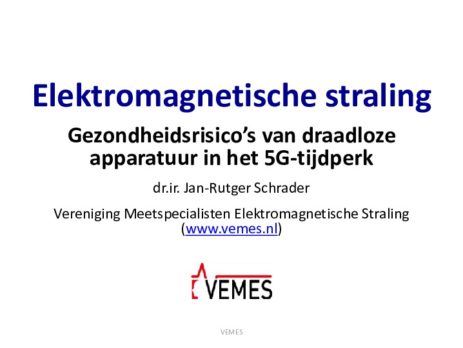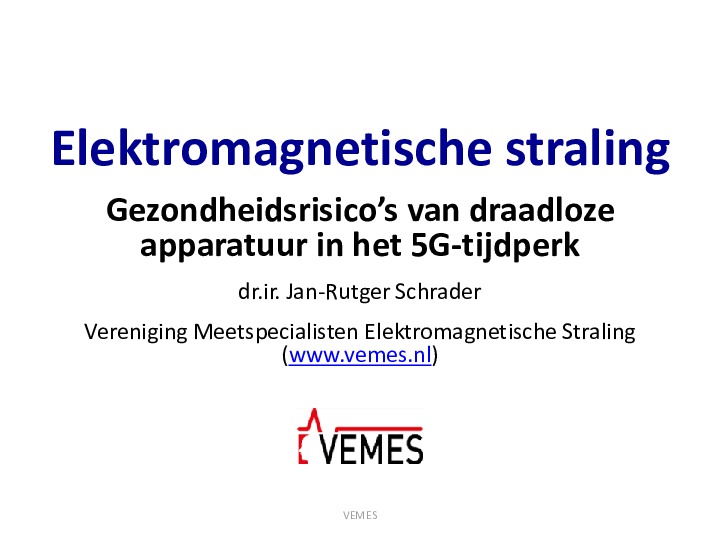Electromagnetic radiation – Health risks of wireless equipment in the 5G era (full lecture transcript)
Expert 5G Meeting Provincial Council of Friesland 11 March 2020
[00:00:00] Hello, my name is Jan-Rutger Schrader. I am an electrical engineer. I was working in the research lab in the south of the country on the latest generation of cell phones. Whilst there it became clear to me that wireless technology was having a noticeable effect on my health and I felt I could no longer work in the wireless industry. I am a member of the Dutch Association of Measurement Specialists in Electromagnetic Radiation (VEMES). We offer EMF measurements to people who have complaints at home or in the office due to electromagnetic radiation from cell towers or wireless equipment. I run my own business in which I also make and design equipment that emits less radiation, measurably.
[00:00:44] I wanted to start with a short video to indicate the whole economic dynamics of the story. This is from a documentary, still from the 3G generation. From Zembla 2004 (at bottom of page).
[00:01:10] A UMTS antenna radiates at a higher frequency than a GSM mast and twice as many masts are needed. Telecom companies have a lot of money to spend on UMTS frequencies, but there has to be something in return. In rolling out the GSM network, they encountered many problems from citizens and municipalities.
[00:01:31] CEO of cell phone carrier Telfort: We did foresee that UMTS was going to cause even more problems, so we wanted at least, before UMTS was actually built, to have it taken care of. And so it started as early as 19.., the last century, so to speak, that we said to the government: you must all ensure that antennas can be built without too many problems, because otherwise we’ll be a lot less enthusiastic.
[00:01:58] Interviewer: But wasn’t the very approach at the time to ensure that citizens and municipalities could not hold up the rollout of that network?
[00:02:06] CEO of cell phone carrier KPN: Yes, that’s right. I mean, we had at the time, ‘we’ I say, in my KPN time in Belgium, the extreme situation that for more than a year there was a kind of total moratorium on expansion, given this kind of discussion. Well, that’s almost lethal from a commercial point of view, and of course, it was. So it was clearly said at the time: listen, we have a lot of money to spend on those frequencies, but then we don’t want too much burden from citizens and municipalities.
[00:02:30] And so it is settled. Illegal masts are legalized and masts up to five meters high become permit-free. In the summer of 2000, the government organizes an auction of UMTS frequencies. The auction will earn the government six billion guilders.
[00:02:49] CEO of cell phone carrier Telfort: The moment the government says, And now no further, well, you are asking for trouble as a government.
[00:02:53] Interviewer: So the government had no choice after the COFAM study came out?
[00:02:56] CEO of cell phone carrier Telfort: No, in my opinion, it didn’t. No, they can never say: Guys, hold your horses. Pass. Because if they did then of course there would be a claim immediately.
Note: the COFAM study, conducted by the acclaimed national institute TNO, was problematic for industry because it showed an effect of 3G on people’s well-being. The end of the story was that the industry financed, at least in part, a Swiss replication study that of course showed no effect. And the rollout of 3G continued.
[00:03:07] CEO of cell phone carrier KPN: In part, the train rolls on because the licenses are there. Simple as it is. And b, there is now a powerful industry behind it. They have not bought licenses, but they have invested x years of research. And one way or another, they’ll make it happen anyway.
[00:03:26] CEO of cell phone carrier Telfort: If something like that happens, then of course the operators are the first to say to the government: Well, we’d like to have that six billion back, too. On top of that, we then want an additional six billion compensation for all the investments we’ve already made.
Note: In 2002, the industry paid six billion in license fees to the Dutch government for the 3G frequencies.
[00:03:52] What is also important to note is that the Antenna Bureau is 100% financed by Economic Affairs. And from a WOB request it was discovered that the Knowledge Platform is financed 1/3 by the telecom, 1/3 by the energy companies and 1/3 by Economic Affairs.
Note: the Antenna Bureau provides ‘information and education’ to citizens, for example in the form of information evenings for the ‘concerned community’, in which the risks of transmission masts are always downplayed.
[00:04:19] This is important to consider. The timeframe of the 5G rollout. In 2020, so this year, we will auction off the 700 Megahertz. That first is actually a situation of “4G+,” you might say. It’s still the lower frequencies that are actually similar in physics to what we have today in terms of wireless systems as well. In 2022, in which the Netherlands is a bit behind, only the 3.5 Gigahertz will be auctioned because it is currently still militarily occupied, as the Antenna Bureau also mentioned. And in 2023, full 5G will start. And that is the 26 Gigahertz frequency which is substantially different. The expected revenue from the frequency auction is 900 million for the government for the first 700 Megahertz, and then the 3.5 Gigahertz, then 26 Gigahertz. And keep in mind that in 2004 for 3G the revenue was six billion. Well, add the inflation to that. So it’s important to keep in mind that there are big financial stakes involved.
[00:05:27] 26 gigahertz is a ten times higher frequency than 4G. What does that mean? Well, there is actually no research done on 5G and the skin. So what happens is that the same transmit power is used by the providers, so they can go all the way up to 40 volts per meter, just like in the previous generations. But all that energy is absorbed into the skin. So that’s a much higher energy absorption per cubic centimeter of body, because it’s completely absorbed into your skin and into the cornea of the eye. I don’t think there’s any reason to assume it’s safe. So we are basically guinea pigs.
[00:06:16] Well, this has also just been touched on briefly. What is new with 5G is beamforming, so beamforming antennas are used. At the bottom left you can see such an antenna. That antenna contains 64 strips. Those are controlled in such a way that this is effectively a kind of dish, a kind of directional antenna that you can change direction at lightning speed, so that you can focus that beam on the phones that are connected, so that you can thus focus a 64 times amplified radiation intensity on those phones. Well, what is it all about in the end? So it’s all about the bandwidth (bottom right). So they want to transmit very broadband so we can send 10 gigabits per second through the air. And that is the real new technology, which the industry wants to sell to the people eventually.
[00:07:12] So if you look at this picture for a second, think about the comment of just 10% additional sites. I think you have to be very critical about that. There is talk about self-driving cars and the Internet of Things. Well, a self-driving car with such a system at 26 gigahertz where you have 200 meters of range from a mast is not really a viable technology case in the end. The Internet of Things, those are very low bandwidths. Then you talk, for example, about a lamppost .
[00:07:48] No, the real application of these 26 gigahertz frequencies at 10 gigabits per second, that’s you walking from mast to mast in a fantasy world with virtual reality glasses on, on the street with a 4K picture. These are applications that are truly technologically new. And that’s something we don’t have right now in terms of radiation. It was said: at 5G test sites a very low field strength is measured. But that’s only that 3.5 gigahertz. The 26 gigahertz is not there at all yet and therefore has not been measured. A David and Goliath battle is currently raging in Switzerland. There, the official federal environmental agency even says: we have no reference at all to say how much radiation may a 5G mast give. So we have yet to set those up, those new exposure limits, so take a step back. And various cantons, including the canton of Geneva, who have declared a three-year moratorium on 5G. So there’s a lot to be said, especially about that higher frequency. What does it do to the skin? That is totally unknown.
[00:09:15] Dutch people who want guarantees for their safety. No research has yet been done on 5G. Dutch people think that it should first be clear what the safety studies are and what the health risks are. There are many protests worldwide. One I want to pick out is the doctors who took to the streets in Stuttgart. And who say: we see many people in our practices who experience complaints. These include tinnitus, sleep problems and the like. We also see that those people improve when you reduce the measurable exposure. So we would tell the government to be cautious.
[00:10:12] This is from the Austrian Chamber of Physicians. These have even released a complete treatment guideline for health problems due to electromagnetic radiation.
[00:10:30] Not much epidemiological research has been done and this study of people near transmission towers and health complaints is relatively old. You can hardly do it anymore because there are cell towers everywhere. But from the studies that have been done, there have been results. One is from Hutter in Austria. That’s a study with 365 respondents. In two different regions of Austria, double-blind. People didn’t know it was about cell towers. Other environmental factors were also asked about. People had symptoms significantly more often.
[00:11:14] The Bioinitiative report is a very large collection of studies. 1800 studies from 29 scientific authors. What emerges: effects on genes and proteins, genotoxic effects, DNA damage. So this is literally based on 1800 scientific studies. DNA stress response, effects on the immune system, neurological and behavioral influences. Brain tumors, childhood leukemia. This is mainly due to high-voltage power lines. Effects on melatonin production, Alzheimer’s disease, in people living under power lines. Breast cancer. So those studies are all out there. So you can’t claim with dry eyes that there is no evidence. One of the key issues that is also always a matter of debate is DNA damage. In 2004, the European Reflex research project was commissioned by the EU and carried out by twelve institutes for a total budget of 3 million euros. The results show that even at a SAR value of 1.3 watts per kilogram, representative of many cell phones, significant biological damage is done in human cells and DNA. So that EU Reflex study shows that long-term radiation from a cell phone causes genetic damage. Just like radioactive radiation. The comet-assay test is a very sensitive test to detect DNA damage. With electrophoresis, the DNA fragments are pulled out. Hence the tail. And the shorter the fragments, the more DNA breaks, the more clearly that comet tail becomes visible under the microscope. Thus, this demonstrates single and double DNA breaks. Top left in the highlighted image, the control trial, the ‘sham’, which means not exposed. Top right the effect of a 0.5 Gray dose of X-rays on the cell, the equivalent of 250 years of natural background radiation or about 60 CT scans. Bottom: the effect on the cell of radiation at the frequency of a regular cell phone. SAR 1.3 watts per kilogram. Thus, in both cases, a comet with a tail is formed.
[00:13:45] The Reflex study was accused of scientific fraud, particularly by industry-related professor Alexander Lerchl, professor at the private University of Bremen. In 2010, the allegations were all proven false and the Reflex study was cleared of all blame. Lerchl raised a good deal of money between 2002 and 2008 from the industry-funded Deutsches Mobilfunk Forschungsprogramm. The World Health Organization’s IARC committee, which deals with radiofrequency radiation and cancer, rejected Lerchl as a member because of the risk of a conflict of interest.
[00:14:28] This is the NTP study, conducted recently for 15 million in America. It showed that the exposed rats were significantly more likely to develop tumors of the heart. And DNA damage was also seen.
[00:14:49] Well , statistics, you apparently have a choice in that. These are statistics from England. The number of cases of glioblastoma brain tumor has increased tenfold in England. Glioblastoma, the most aggressive and deadly brain tumor, has increased tenfold, while the number of cases of other types of brain tumors is declining. So it seems that the brain tumors that are out there are getting more aggressive.
[00:15:22] Skin cancer in the Netherlands. Very strong increase. So yes, there are epidemiological endpoints. The World Health Organization has indicated : electromagnetic radiation possibly carcinogenic, based on Hardell’s studies of brain tumors resulting from cell phone use.
[00:15:49] The European Parliament said on the basis of this Bio-initiative study: we should start tightening these limits. Also the Council of Europe in resolution 1815 has indicated even 0.2 volts per meter and that means you should not even have WiFi router or DECT phone in your home.
[00:16:14] This is a very important one. This is an appeal by 200 scientists to the European Union, a year after the launch of the European Union’s ambitious 100 billion 5G action plan. A group of more than 230 scientists is calling on the European Commission to suspend its plans. So the doctors, scientists and researchers all signed the 5G Appeal petition. In it, they write that with the next generation of wireless technology, the radiation from electromagnetic fields will increase exponentially. And as scientific evidence of its harmful effects grows, they are asking that 5G not be rolled out until there is more clarity on whether and how harmful the radiation is to people.
[00:17:09] These are all DNA studies. So just like the Reflex study that just came along. That was one of the first, currently there are hundred studies of DNA damage. Even the mechanism of action is known. That’s oxidative stress. These are free oxygen radicals. The studies above did find an effect of cell phones on DNA damage. The studies below found no effect. If you start coloring them with “Who paid for it?”, you’ll see a very clear effect. Red means that they were paid for by the wireless industry or by the U.S. military. So there’s a very clear funding bias in there.
[00:17:56] Well, these are the biological effects that have now been established. I just read that one too. Also an EEG/ECG change for example. Blood-brain barrier.
[00:18:09] This is another one about funding bias, by Anke Huss, who is now on the Dutch Health Council, Electromagnetic Fields Committee.
[00:18:18] Then the insurers. Swiss Re is one of the largest reinsurers in the world. Swiss Re writes in its report: concerns about the potential risks of electromagnetic fields have increased. Studies are difficult to conduct because Trend Studies are inconsistent over time due to wireless technology still being relatively new. WHO has classified radiofrequency electromagnetic radiation, such as that emitted by cell phones, as potentially carcinogenic to humans. Class 2B carcinogen.
[00:18:57] Moreover, a recent ruling by an Italian court suggests a link between cell phone radiation and human health impairment. Overall, however, scientific studies are still inconclusive about the potential adverse health effects of EMF. If a direct link is made between EMF and human health problems, would this open the door for new claims and could ultimately lead to large losses under product liability coverage? Liability figures would likely increase.
[00:19:38] A very large Austrian insurer has done its own research, finds effects on EEG and also finds effect on protein replication. Lloyd’s of London, also one of the largest insurers.
[00:20:08] Liability of cell phone manufacturers. Take a look in your iPhone at the information, the legal bit. You have to hold the phone an inch from your head or it will go over ICNIRP limits. Liability goes from pillar to post. It’s a tar baby being passed around. The asbestos history: this was not insurable by insurance companies as early as 1918, and was banned in the Netherlands in 1993. Eventually.
[00:20:47] I’m going to skip this for the time being. I have a meter that allows me to show radiation, but I’m going to skip this one. That’s to indicate that there is indeed measurable radiation coming from a phone. Measuring is knowing. It is a physical phenomenon. And the closer you sit to the phone, the closer you are to the cell tower, the more radiation.
[00:21:09] The exposure limits, they also just came along briefly. In the middle you see the Dutch exposure limits. Those are actually “safely high” – for the industry. You are allowed to stay, sleep, live within two meters of a cell tower, as a Dutch citizen, for 24 hours. If you start looking at what is actually being measured in the city, you end up with a few Volts per meter. So you see that there that there are much lower standards and advice like those of the EU appeal, from the perspective of building biology.
[00:21:47] So what you have now in Switzerland: a David and Goliath battle, the discussion that the providers want to raise their limits even further, because they obviously need more, with the new 5G ‘small cells’ which of course have to be at street level, which will mean that people will be much closer to transmitters. Well, this is a picture with various biological effects filled in from studies, to show that they take place well below the limits. Actually, Western exposure limits are, in nearly all European countries, based on ICNIRP exposure limits. Well, what is the ICNIRP? This is a private non-governmental organization.
[00:22:33] They accept only acute heating effects of one degree Celsius, but thousands of studies of biological effects such as DNA damage occur below these limits. In 2016, a study was released by Starkey. She did a whole study on the INCIRP, what the basis is of their limits. It turns out that in the analysis of the ICNIRP, 40 DNA studies are missing, 40 free radical studies are missing and 22 studies on male fertility are simply left out. For high-voltage lines, the legal limit is still 100,000. The RIVM advisory limit was already 400 nanotesla in 2005, based on nine epidemiological studies of childhood leukemia. Homes have been bought out by the govt., but still the official limit is 100,000. If you look at the Dutch Health Council, this is Chairman Professor Kromhout of the Health Council’s own Electromagnetic Fields Committee. He literally says: It’s pretty crazy that, driven by technology, we’re going to expose an entire population to something that we’re not sure will hurt or not.
[00:23:57] Well then I come to the conclusions. What actions can you take as a municipality and as a province? We see that there is now a proposal for an amendment to the Telecommunications Act. There has been much criticism of this, through the submission of views by municipalities. Eindhoven and Maastricht, among others, have submitted letters.
[00:24:20] That change in the law means that as a municipality you can no longer refuse antennas on the grounds of public health. Municipalities are wondering about liability for health damage. The city of Maastricht was a 5G test site without being informed.
[00:24:38] What can you do as a province? Here is an example in Flevoland. About home connections. Because of course we have the mobile usage when you’re on the road, but home connections, please run glass fiber cable and facilitate and fund it. Fiber optics is: 10,000 gigabits per second per fiber. So each of these wires here, and there are about a 100 of them in one cable, can carry 10,000 gigabits per second, so this will always be way faster than 5, 6 or 7G. The Netherlands has an ideal soil for laying fiberglass, unlike a country like Spain where you have all rocky soil for example. This is a grant opportunity. If you encourage this and make co-payment for people low in the countryside, you can build a future-proof network that will simply last 100 years. And that’s a one-time investment for the digging activities.
[00:25:41] Then I come to the conclusions. There are indeed adverse biological effects and symptoms in the short and long term. The Dutch ICNIRP based standards are unsafe and will become even more unsafe with 5G. And the introduction of 5G, especially the higher frequencies, is a major risk. That’s it, thank you.
[00:26:03] Thank you very much, Mr. Schrader.
PDF of presentation slides (in Dutch)
The full video recording of the Expert 5G Meeting of March 11, 2020, with 4 speakers and question-and-answer at the end, incl. all PDFs of the presentations, is available here on the website of Provincial States of Friesland (speaker 3).




